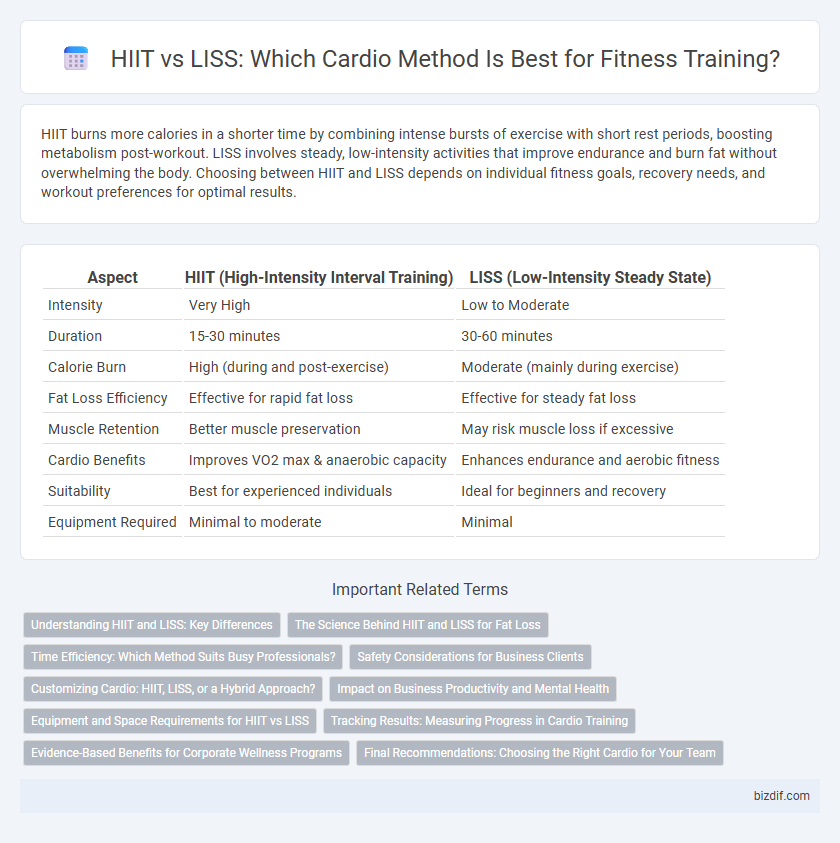HIIT burns more calories in a shorter time by combining intense bursts of exercise with short rest periods, boosting metabolism post-workout. LISS involves steady, low-intensity activities that improve endurance and burn fat without overwhelming the body. Choosing between HIIT and LISS depends on individual fitness goals, recovery needs, and workout preferences for optimal results.
Table of Comparison
| Aspect | HIIT (High-Intensity Interval Training) | LISS (Low-Intensity Steady State) |
|---|---|---|
| Intensity | Very High | Low to Moderate |
| Duration | 15-30 minutes | 30-60 minutes |
| Calorie Burn | High (during and post-exercise) | Moderate (mainly during exercise) |
| Fat Loss Efficiency | Effective for rapid fat loss | Effective for steady fat loss |
| Muscle Retention | Better muscle preservation | May risk muscle loss if excessive |
| Cardio Benefits | Improves VO2 max & anaerobic capacity | Enhances endurance and aerobic fitness |
| Suitability | Best for experienced individuals | Ideal for beginners and recovery |
| Equipment Required | Minimal to moderate | Minimal |
Understanding HIIT and LISS: Key Differences
High-Intensity Interval Training (HIIT) involves short bursts of intense exercise followed by brief recovery periods, maximizing calorie burn and cardiovascular improvement in less time. Low-Intensity Steady State (LISS) focuses on prolonged, steady-paced activities like walking or cycling, enhancing endurance and fat metabolism with lower impact stress on joints. Understanding these differences helps tailor fitness plans to individual goals, whether prioritizing rapid fat loss, endurance building, or joint-friendly workouts.
The Science Behind HIIT and LISS for Fat Loss
HIIT (High-Intensity Interval Training) and LISS (Low-Intensity Steady State) both stimulate fat loss by creating a calorie deficit, but they use different physiological mechanisms. HIIT triggers a higher post-exercise oxygen consumption (EPOC), which accelerates metabolism and burns more calories after the workout, whereas LISS relies on prolonged fat oxidation during extended steady cardio sessions. Studies show HIIT can improve insulin sensitivity and cardiovascular fitness faster, while LISS supports sustained fat burning with lower injury risk and greater exercise adherence.
Time Efficiency: Which Method Suits Busy Professionals?
HIIT workouts burn more calories in less time, making them ideal for busy professionals with tight schedules seeking maximum fat loss and cardiovascular improvement. LISS offers lower-intensity exercise that lasts longer, suitable for those preferring steady-state cardio with minimal joint stress. Choosing between HIIT and LISS depends on individual time availability, fitness goals, and recovery capacity.
Safety Considerations for Business Clients
High-Intensity Interval Training (HIIT) poses greater cardiovascular and injury risks compared to Low-Intensity Steady State (LISS) for business clients with sedentary lifestyles or preexisting conditions. LISS offers a safer alternative by promoting fat loss and endurance through sustained moderate exercise, reducing strain on joints and heart. Proper medical screening and personalized intensity adjustments are essential to ensure client safety and maximize training effectiveness.
Customizing Cardio: HIIT, LISS, or a Hybrid Approach?
Customizing cardio workouts involves selecting between HIIT (High-Intensity Interval Training), LISS (Low-Intensity Steady State), or a hybrid approach based on individual fitness goals and recovery capacity. HIIT maximizes calorie burn and cardiovascular improvements in shorter time frames, while LISS supports fat oxidation and endurance with lower joint impact. Integrating both methods can optimize metabolic adaptation, balance training stress, and enhance overall aerobic capacity for personalized fitness progress.
Impact on Business Productivity and Mental Health
HIIT (High-Intensity Interval Training) and LISS (Low-Intensity Steady State) impact business productivity by enhancing cognitive function and reducing stress levels. HIIT boosts endorphin release and improves focus through short bursts of intense activity, leading to increased work efficiency. LISS supports mental health by promoting relaxation and sustained energy levels, which helps maintain consistent productivity throughout the workday.
Equipment and Space Requirements for HIIT vs LISS
HIIT (High-Intensity Interval Training) typically requires minimal equipment and limited space, as exercises like burpees, jump squats, and sprints can be performed using body weight in small areas. LISS (Low-Intensity Steady State) often needs more consistent, larger space or equipment such as treadmills, stationary bikes, or elliptical machines for extended periods at a steady pace. Choosing between HIIT and LISS depends on available space and access to gym equipment, with HIIT being more adaptable to home workouts or confined environments.
Tracking Results: Measuring Progress in Cardio Training
Tracking progress in HIIT and LISS cardio training involves monitoring metrics such as heart rate variability, calorie burn, and endurance improvements using wearable devices or fitness apps. HIIT sessions typically show rapid gains in cardio capacity and fat loss, while LISS offers gradual enhancements in aerobic base and recovery efficiency. Consistently logging workout intensity, duration, and subjective exertion scales ensures accurate assessment of improvements and helps tailor ongoing fitness plans.
Evidence-Based Benefits for Corporate Wellness Programs
High-Intensity Interval Training (HIIT) significantly improves cardiovascular fitness and metabolic rate in shorter time frames, making it ideal for busy corporate employees seeking efficient workouts. Low-Intensity Steady State (LISS) exercise promotes fat oxidation and endurance while offering lower injury risk, supporting sustainable fitness habits for long-term wellness. Implementing a blend of HIIT and LISS in corporate wellness programs enhances overall employee health, productivity, and reduces absenteeism through evidence-based physical activity interventions.
Final Recommendations: Choosing the Right Cardio for Your Team
Final recommendations for selecting between HIIT and LISS cardio depend on team goals and fitness levels. HIIT provides efficient calorie burn and improves cardiovascular performance in shorter sessions, ideal for teams seeking intense, time-effective workouts. LISS supports longer-duration endurance building and active recovery, suited for teams prioritizing fat loss with lower injury risk.
HIIT vs LISS Infographic

 bizdif.com
bizdif.com